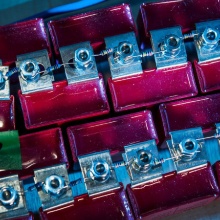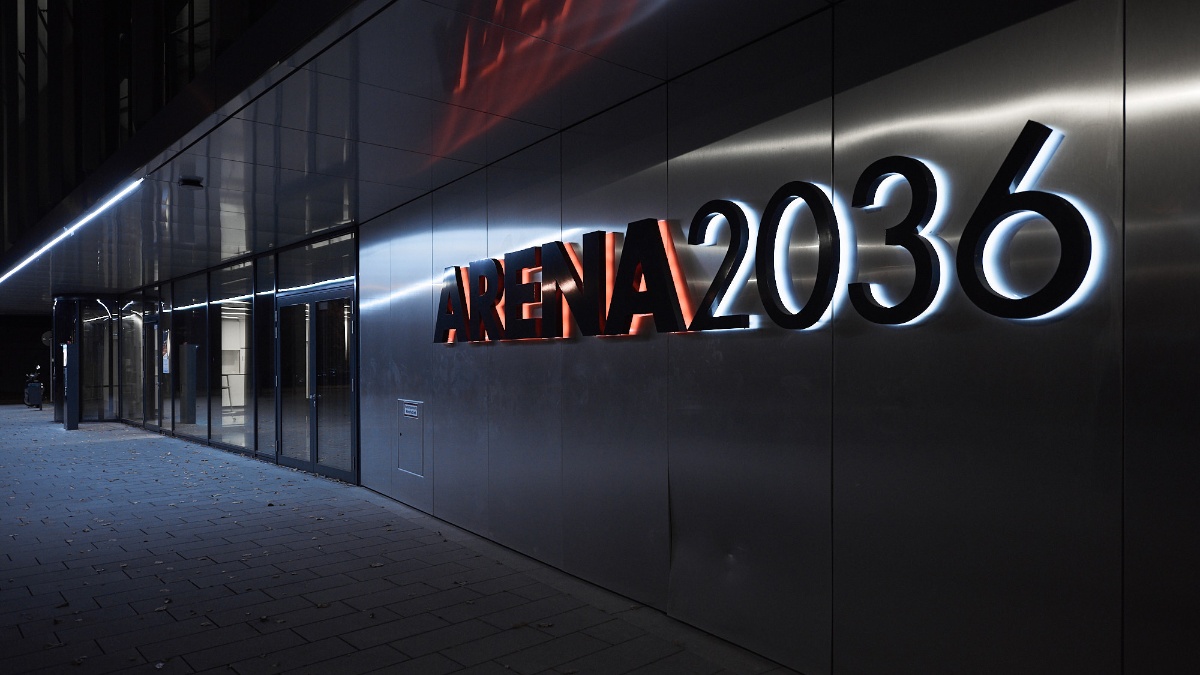The parking lot on the Campus Vaihingen of the University of Stuttgart is busy. A deliveryman is ringing at No. 19 Pfaffenwaldring. Behind the door is a large hall with adjoining workshops, laboratories, and offices. The distinctive jagged roof is visible from afar. There is a logo shining on the facade: “ARENA2036”, which has a bright orange background, and “Universität Stuttgart” (University of Stuttgart), which is in anthracite.
Joint research on the car of the future
ARENA2036 – a telling name: Active Research Environment for the Next generation of Automobiles. “2036” refers to the 150th anniversary of the invention of the car, aiming for the future. Mobility is expected to be sustainable. To this end, ARENA2036 is making use of lightweight design, new production technologies, electrification, and the integration of modular and autonomous systems.
“Research institutions and companies that previously conducted research independently of each other are now located under one roof,” Executive Director Peter Froeschle describes the basic idea. This allows university research to be tested directly in industrial applications. Boundaries are disappearing not only between science and business. Student start-ups are refining their inventions alongside big players like Bosch and Daimler. “STARTUP AUTOBAHN” creates space for young inventive talent. The innovation platform has its own area in the building. Colorful sticky notes on transparent boards on the right combine the hip entrepreneurial spirit of big cities with down-to-earth Swabian engineering skills. The “Wall of Fame” on the left attests to success.
“In the beginning, each company had its marked-out area in the production hall,” remembers Javier Stillig from Bosch Rexroth AG. “Then we moved closer and closer together – now you can hardly see any dividing lines anymore. We work in a network and use synergies.” Soon, everyone will also get the same desk model.
Inductive power supply in Industry 4.0
Stillig is doing his doctoral degree at the University of Stuttgart on the topic of “Wireless Power Transfer in Industrial Environments”. You can walk on his Industry 4.0 invention: the intelligent floor. Weight sensors light up LEDs with every step. They also serve as a guidance system so that transport boxes can go on their way alone. Stillig points at the high walls and explains: “In the classic production hall, electrical supply lines are installed on walls and ceilings to keep the machines running.”
However, the trend is toward individualization and speed, and thus toward changeable production. As a consequence, the production hall, too, needs to adapt to the new requirements and become flexible itself. While everything in the room becomes mobile, the floor remains the same: The idea of the intelligent floor was born. Through inductive charging, it can provide wireless power supply. You don’t need annoying cables anymore. Other features can be integrated. For example, the Pilz company installed a module for occupational safety in a floor slab.
Resource-friendly and emission-free mobility
Inductive charging while driving is a topic of Prof. Nejila Parspour, who supervises Stillig’s doctoral research project. The head of the Institute of Electrical Energy Conversion at the University of Stuttgart was initially involved in robotics. “The car of the future can be seen as a robot, so basically it’s the same thing,” she says. Regarding her personal research motivation, she tells us: “Anything that helps others fascinates me.” That’s why Parspour uses induction not only for cars, but also for exoskeletons and heart pumps. Sustainable mobility is also very important to her.
We have only one Earth, one atmosphere, and limited resources.
Prof. Nejila Parspour
To be able to combine the idea of sustainability with innovation, knowledge is pooled at the Innovation Campus Future Mobility (ICM), which is a cooperation between the University of Stuttgart and the Karlsruhe Institute of Technology that is funded by the state of Baden-Wuerttemberg. “The skills of the scientists from Stuttgart and Karlsruhe complement one another perfectly both in basic research and in technology transfer,” believes Dr. Max Hoßfeld, who is the Stuttgart Executive Director of ICM.
Besides flexible and digital production, the focus is on emission-free drive systems. Parspour’s electric motors, in which the charging system is directly integrated so that they do not rely on conventional batteries, achieve an efficiency of 96 percent. There will even be a research road at Campus Vaihingen, where inductive charging can be tested while the vehicle is driving. Busy parking lots and deliverymen ringing at doors on Pfaffenwaldring – they are subjected to a changing mobility.
And in the production hall itself? – “When I think of the future, I see a swarm of flying robots, small flying tool drones with different tasks, and larger robots that fly and transfer energy to them,” imagines Parspour with enthusiasm.







